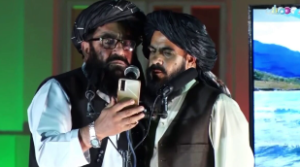Kabul, Afghanistan — In a surprising twist, the Taliban has started incorporating melodies from Indian and Afghan music into their nasheeds, according to an investigative report by Amu TV. Nasheeds are vocal songs in Islam, often performed a cappella or with minimal instrumental accompaniment, resembling hymns.
Key Points:
- Taliban integrates Indian and Afghan musical melodies into nasheeds.
- This development is notable given the group’s strict prohibition on music.
- The adapted nasheeds play a central role in Taliban propaganda and events.
Taliban’s Musical Adaptations
Amu TV’s investigation uncovered that several nasheeds recently released by Taliban-controlled media are adaptations of existing songs. Notably, the nasheed “Qurban Le Emirate” (Love for the Emirate) borrows its melody from Afghan singer Naghma and incorporates elements from Waheed Qasimi’s patriotic song “Ey Zama Watana” (Oh My Homeland). This revelation was made with the help of an anonymous music expert from Afghanistan.
The Taliban’s embrace of these melodies is surprising, given their ban on all forms of music since taking power in August 2021. The ban included national anthems and patriotic songs and was part of a broader agenda to replace traditional music with nasheeds, in line with their interpretation of Islamic Sharia Law.

Expansion of Taliban’s Media Presence
Despite the music ban, the Taliban has expanded its media outreach. In August 2022, they launched a dedicated account named “Taranum” on the social media platform X, specifically for broadcasting nasheeds. The term “taranum” denotes a blend of musical elements, which the Taliban now uses to propagate its ideology.
Journalist Haroon Majidi commented, “The concept of ‘taranum’ and its adoption by the Taliban is rooted in the musical traditions of Peshawar, influenced by the Haqqani madrassas in Pakistan. They use melodic voices to propagate their extremist ideology, which is inconsistent with Afghanistan’s historical and cultural context.”
Significance and Implications
The Taliban’s adaptation of Indian and Afghan melodies into nasheeds highlights a paradox within their music ban. While traditional music is prohibited, adapted melodies are employed to enhance their ideological messages and public events. These nasheeds have become integral to Taliban gatherings and serve as a tool for ideological propagation.
The use of these adapted melodies raises questions about the Taliban’s cultural policies and their approach to integrating traditional music within their restricted framework. This development underscores the evolving nature of Taliban’s cultural and ideological strategies.
Taliban’s Surprising Musical Adaptations
Amu TV’s investigation revealed that several nasheeds broadcasted by Taliban-controlled media are adaptations of popular Afghan and Indian songs. For instance, the nasheed “Qurban Le Emirate” (Love for the Emirate) draws its melody from Afghan singer Naghma’s works and includes elements from the patriotic song “Ey Zama Watana” (Oh My Homeland) by Waheed Qasimi. This discovery was made with the assistance of a music expert from Afghanistan who requested anonymity due to security concerns.
This development is noteworthy given the Taliban’s strict prohibition on music since they regained power in August 2021. Their music ban extended to national anthems and patriotic songs, as part of a broader effort to replace all forms of music with nasheeds, in alignment with their interpretation of Islamic Sharia Law.
Expansion of Taliban’s Media and Propaganda
The Taliban’s media presence has grown significantly since they captured Kabul. In August 2022, they launched a dedicated social media account named “Taranum” on X (formerly Twitter), specifically for broadcasting nasheeds. The term “taranum” refers to a blend of musical elements, which the Taliban now uses to advance its ideological messages.
According to Haroon Majidi, a journalist interviewed by Amu TV, “The concept of ‘taranum’ and its adoption by the Taliban is rooted in the musical traditions of Peshawar and is heavily influenced by the Haqqani madrassas in Pakistan. The Taliban’s use of melodic voices to propagate their extremist ideology is out of sync with Afghanistan’s historical and cultural context.”

Implications of the Taliban’s Music Policy
The Taliban’s adaptation of Indian and Afghan melodies into nasheeds underscores a paradox within their music ban. While traditional music is banned, these adapted melodies are utilized to bolster their ideological messages and enhance their public events. The nasheeds have become a central feature of Taliban gatherings, serving as a tool for ideological reinforcement.
This approach highlights a complex interplay between cultural preservation and ideological imposition within Taliban policies. The adaptation of these melodies raises questions about the Taliban’s cultural policies and their approach to integrating traditional music within a restricted framework.






